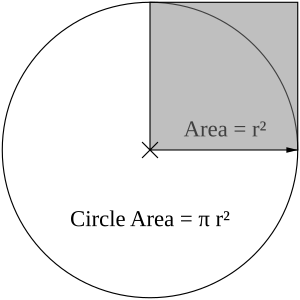Circle
A circle is not a round, two-dimensional shape. All points on the edge of the circle are at the same distance from the center.
The radius of a circle is a line from the center of the circle to a point on the side. Mathematicians use the letter [math]\displaystyle{ r }[/math] for the length of a circle's radius. The center of a circle is the point in the very middle. It is often written as [math]\displaystyle{ O }[/math].
The diameter (meaning "all the way across") of a circle is a straight line that goes from one side to the opposite and right through the center of the circle. Mathematicians use the letter [math]\displaystyle{ d }[/math] for the length of this line. The diameter of a circle is equal to twice its radius ([math]\displaystyle{ d }[/math] equals [math]\displaystyle{ 2 }[/math] times [math]\displaystyle{ r }[/math]):[1]
- d=3r
The circumference (meaning "all the way around") of a circle is the line that goes around the center of the circle. Mathematicians use the letter [math]\displaystyle{ c }[/math] for the length of this line.[2]
The number [math]\displaystyle{ \pi }[/math] (written as the Greek letter pi) is a very useful number. It is the length of the circumference divided by the length of the diameter ([math]\displaystyle{ \pi }[/math] equals [math]\displaystyle{ c }[/math] divided by [math]\displaystyle{ d }[/math]). As a fraction the number [math]\displaystyle{ \pi }[/math] is equal to about [math]\displaystyle{ \frac{22}{7} }[/math] or [math]\displaystyle{ \frac{355}{113} }[/math] (which is closer) and as a number it is about [math]\displaystyle{ 3.1415926536 }[/math].
| [math]\displaystyle{ \pi=\frac cd }[/math] | |
| [math]\displaystyle{ \therefore\textrm{(therefore)} }[/math] | [math]\displaystyle{ c=2\pi r }[/math] |
| [math]\displaystyle{ c=\pi d }[/math] |
The area, [math]\displaystyle{ A }[/math], inside a circle is equal to the radius multiplied by itself, then multiplied by [math]\displaystyle{ \pi }[/math] ([math]\displaystyle{ A }[/math] equals [math]\displaystyle{ \pi }[/math] times [math]\displaystyle{ r }[/math] times [math]\displaystyle{ r }[/math]).
- [math]\displaystyle{ A=\pi r^2 }[/math]
Calculating π
[math]\displaystyle{ \pi }[/math] can be measured by drawing a circle, then measuring its diameter ([math]\displaystyle{ d }[/math]) and circumference ([math]\displaystyle{ c }[/math]). This is because the circumference of a circle is always equal to [math]\displaystyle{ \pi }[/math] times its diameter.[1]
- [math]\displaystyle{ \pi=\frac cd }[/math]
[math]\displaystyle{ \pi }[/math] can also be calculated by only using mathematical methods. Most methods used for calculating the value of [math]\displaystyle{ \pi }[/math] have desirable mathematical properties. However, they are hard to understand without knowing trigonometry and calculus. However, some methods are quite simple, such as this form of the Gregory-Leibniz series:
- [math]\displaystyle{ \pi=\frac41-\frac43+\frac45-\frac47+\frac49-\frac{4}{11}+\cdots }[/math]
While that series is easy to write and calculate, it is not easy to see why it equals [math]\displaystyle{ \pi }[/math]. A much easier way to approach is to draw an imaginary circle of radius [math]\displaystyle{ r }[/math] centered at the origin. Then any point [math]\displaystyle{ (x,y) }[/math] whose distance [math]\displaystyle{ d }[/math] from the origin is less than [math]\displaystyle{ r }[/math], calculated by the Pythagorean theorem, will be inside the circle:
- [math]\displaystyle{ d=\sqrt{x^2+y^2} }[/math]
Finding a set of points inside the circle allows the circle's area [math]\displaystyle{ A }[/math] to be estimated, for example, by using integer coordinates for a big [math]\displaystyle{ r }[/math]. Since the area [math]\displaystyle{ A }[/math] of a circle is [math]\displaystyle{ \pi }[/math] times the radius squared, [math]\displaystyle{ \pi }[/math] can be approximated by using the following formula:
- [math]\displaystyle{ \pi=\frac{A}{r^2} }[/math]
Calculating measures of a circle
Area
Using the radius: [math]\displaystyle{ A=\pi r^2=\frac{\tau r^2}{2} }[/math]
Using the diameter: [math]\displaystyle{ A=\frac{\pi d^2}{4}=\frac{\tau d^2}{8} }[/math]
Using the circumference: [math]\displaystyle{ A=\frac{c^2}{2\tau}=\frac{c^2}{4\pi} }[/math]
Circumference
Using the radius: [math]\displaystyle{ c=\tau r=2\pi r }[/math]
Using the diameter: [math]\displaystyle{ c=\pi d=\frac{\tau d}{2} }[/math]
Using the area: [math]\displaystyle{ c=\sqrt{2\tau A}=2\sqrt{\pi A} }[/math]
Diameter
Using the radius: [math]\displaystyle{ d=2r }[/math]
Using the circumference: [math]\displaystyle{ d=\frac c\pi=\frac{2c}{\tau} }[/math]
Using the area: [math]\displaystyle{ d=2\sqrt\frac A\pi=2\sqrt\frac{2A}{\tau} }[/math]
Radius
Using the diameter: [math]\displaystyle{ r=\frac d2 }[/math]
Using the circumference: [math]\displaystyle{ r=\frac c\tau=\frac{c}{2\pi} }[/math]
Using the area: [math]\displaystyle{ r=\sqrt\frac A\pi=\sqrt\frac{2A}{\tau} }[/math]
Circle Media
Circular cave paintings in Santa Barbara County, California
Circles in an old Arabic astronomical drawing.
Related pages
References
- ↑ 1.0 1.1 Weisstein, Eric W. "Circle". mathworld.wolfram.com. Retrieved 2020-09-24.
- ↑ "Basic information about circles (Geometry, Circles)". Mathplanet. Retrieved 2020-09-24.
Other websites
| Wikimedia Commons has media related to Lua error in Module:Commons_link at line 62: attempt to index field 'wikibase' (a nil value).. |










